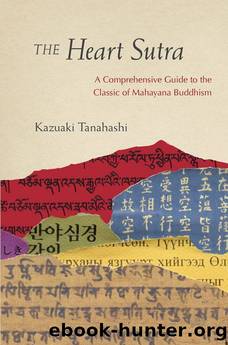The Heart Sutra: A Comprehensive Guide to the Classic of Mahayana Buddhism by Kazuaki Tanahashi

Author:Kazuaki Tanahashi [Tanahashi, Kazuaki]
Language: eng
Format: mobi
Publisher: Shambhala Publications
Published: 2015-03-09T16:00:00+00:00
There have been two major explanations of the etymology of the Pali and Sanskrit feminine noun pÄramitÄ, according to the Japanese Buddhist scholar Hajime Nakamura.11 Here are the two explanations, to which I have added some semantic and grammatical definitions:
1. A compound of pÄram (to the other shore) and ita (having arrived). PÄram means âto the other shoreâ as the accusative case of the neuter noun pÄra â âthe opposite,â âthe other side,â or âthe opposite shore.â The i is a verb meaning âgo,â âget to,â or âarrive.â And the ta makes it a state that has happened, which is turned into tÄ to make the word a feminine noun. Thus, pÄramitÄ can be interpreted as â(the condition of) having arrived at the other shore,â âcomplete attainment,â or âperfection.â
2. A compound of pÄrami, meaning âhaving arrived,â plus tÄ, which makes a state of âhaving completely arrived.â
In the common Buddhist analogy, âthe other shoreâ means âawakening.â âArriving at awakeningâ is no other than enlightenment. This arriving makes a person a buddha. There is also another interpretation. Yuichi Kajiyama suggests:
3. A compound of pÄrami, which derived from parami meaning âthe highest,â plus tÄ, which shows a state or condition. It is an abstract noun meaning âextreme stateâ or âcompletion.â12
As a compound, prajñÄpÄramitÄ is a feminine form. Its personified form, Prajnaparamita, is regarded as a goddess, Mother of All Buddhas, in the Maha yana pantheon.
The six paramitas are regarded as the means by which bodhisattvas lead beings to the shore of nirvana. They are: giving, keeping precepts, patience, vigorous effort, meditation, and prajna. And for Dogen, prajna is multifold.13
In English the six paramitas are often called the âsix perfections.â In a similar manner, prajñÄpÄramitÄ has often been translated as âperfection of wisdom.â You might imagine that when wisdom is perfected, there is nothing more to do; when you have arrived at the shore of enlightenment, there is nowhere else to go.
I invite you to consider paramita as a dynamic state of arriving rather than a static state of having already arrived. The six paramitas may thus be interpreted as the six aspects of practice being actualized.
According to Dogen, as I suggested earlier, our practice should be a dynamic process of actualizing enlightenment and nirvana at each moment in a âcircle of the way.â This point of view suggests that at each moment in which we make an effort to practice, we are not necessarily perfecting something. Thus, pÄramitÄ can be translated as ârealizing,â which can be seen as understanding and actualizing things that are not pre-fixed and not waiting to be perfected.
In the α version, pÄramitÄ is transliterated as boluomi (æ³¢ç¾ è).
In the Xuanzang version, it is boluomiduo (æ³¢ç¾ èå¤). In Japanese these four ideographs are independently pronounced ha ra mitsu ta, but it is actually pronounced ha-ra-mit-ta as a compound by a phonetic change. A phonetic or euphonious change often means that two particular sounds pronounced one after the other create a single shorter sound, or the final sound of a word changes when followed by a certain sound.
Download
This site does not store any files on its server. We only index and link to content provided by other sites. Please contact the content providers to delete copyright contents if any and email us, we'll remove relevant links or contents immediately.
Tools of Titans by Timothy Ferriss(7824)
Crystal Healing for Women by Mariah K. Lyons(7717)
The Witchcraft of Salem Village by Shirley Jackson(7042)
Inner Engineering: A Yogi's Guide to Joy by Sadhguru(6446)
The Four Agreements by Don Miguel Ruiz(6324)
The Power of Now: A Guide to Spiritual Enlightenment by Eckhart Tolle(5345)
Secrets of Antigravity Propulsion: Tesla, UFOs, and Classified Aerospace Technology by Ph.D. Paul A. Laviolette(5002)
The Wisdom of Sundays by Oprah Winfrey(4955)
Room 212 by Kate Stewart(4741)
Pale Blue Dot by Carl Sagan(4627)
Fear by Osho(4496)
The David Icke Guide to the Global Conspiracy (and how to end it) by David Icke(4386)
Rising Strong by Brene Brown(4195)
Animal Frequency by Melissa Alvarez(4156)
How to Change Your Mind by Michael Pollan(4115)
Sigil Witchery by Laura Tempest Zakroff(4033)
Real Magic by Dean Radin PhD(3928)
The Art of Happiness by The Dalai Lama(3851)
Man and His Symbols by Carl Gustav Jung(3847)
